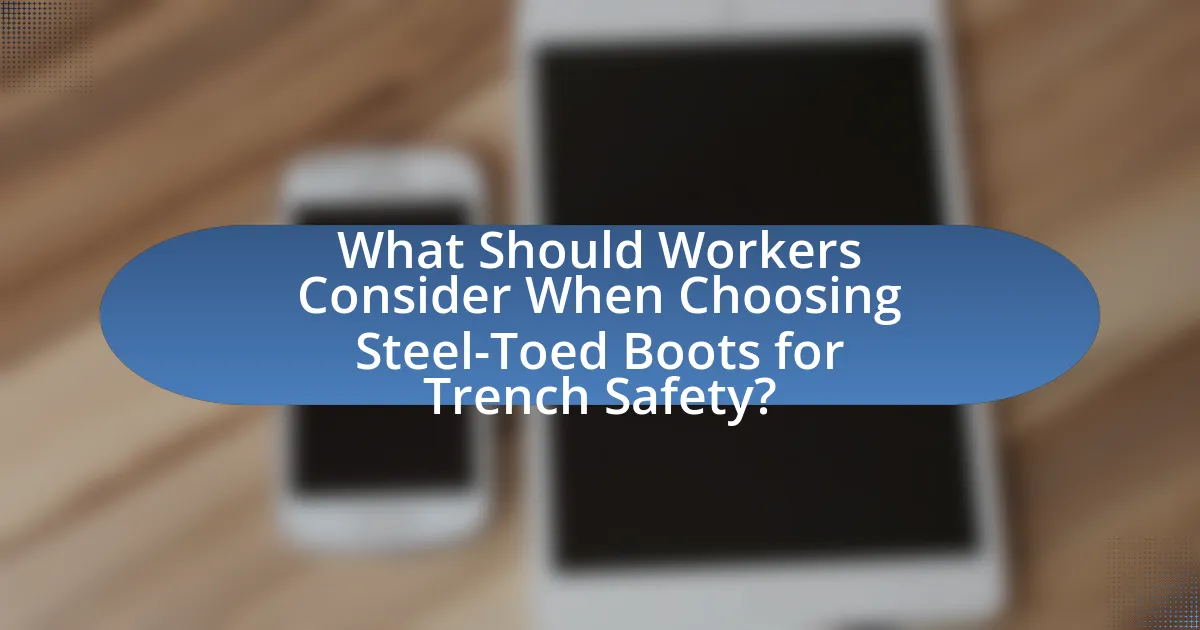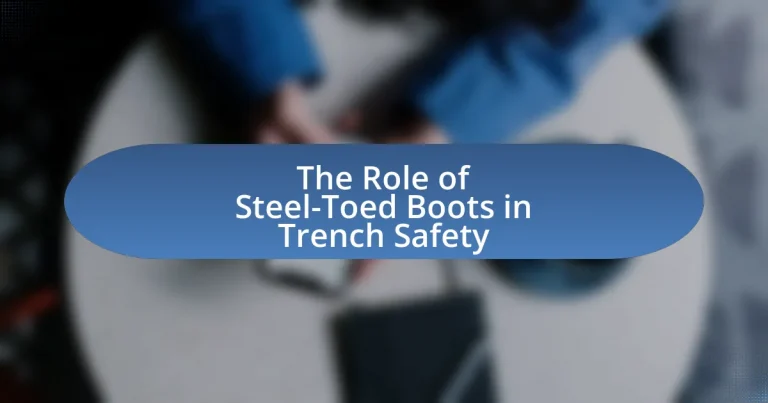Steel-toed boots are specialized footwear designed to protect workers’ feet from heavy objects and impacts, making them essential for trench safety. The article outlines the importance of these boots in preventing injuries caused by falling tools and debris, as mandated by OSHA regulations. Key features such as reinforced toe caps, slip-resistant soles, and puncture-resistant insoles enhance safety in hazardous environments. Additionally, the article discusses the materials used in construction, the necessity of proper fit and comfort, and best practices for maintenance to ensure optimal performance and longevity of steel-toed boots in trench work.

What are Steel-Toed Boots and Their Importance in Trench Safety?
Steel-toed boots are specialized footwear designed with reinforced toe caps to protect the feet from heavy objects and impacts. Their importance in trench safety lies in their ability to prevent injuries caused by falling tools, equipment, or debris, which are common hazards in trench environments. According to the Occupational Safety and Health Administration (OSHA), proper footwear, including steel-toed boots, is essential for workers in construction and excavation sites to reduce the risk of foot injuries, which can lead to significant downtime and medical costs.
How do Steel-Toed Boots protect workers in trenches?
Steel-toed boots protect workers in trenches by providing essential foot protection against heavy objects and potential hazards. The reinforced steel toe cap can withstand impacts of up to 75 pounds, significantly reducing the risk of foot injuries from falling tools or materials. Additionally, these boots often feature slip-resistant soles, which enhance traction on uneven or wet surfaces commonly found in trench environments, further preventing slips and falls. The combination of impact resistance and improved grip makes steel-toed boots a critical safety measure for workers operating in trenches.
What materials are used in the construction of Steel-Toed Boots?
Steel-toed boots are primarily constructed using leather, rubber, and steel. Leather serves as the outer material, providing durability and protection, while rubber is used for the sole, offering traction and flexibility. The steel toe cap is integrated into the boot to protect the toes from heavy impacts and compression. These materials are specifically chosen for their strength and ability to withstand harsh working conditions, making steel-toed boots essential for safety in environments like trenches.
How do the design features of Steel-Toed Boots enhance safety?
Steel-toed boots enhance safety primarily through their reinforced toe caps, which protect the feet from heavy objects and impacts. These boots are designed with materials such as steel or composite materials that can withstand significant force, often rated to endure impacts of up to 75 to 100 joules, depending on the specific standards they meet. Additionally, steel-toed boots often feature slip-resistant soles, which reduce the risk of slips and falls in hazardous environments, and puncture-resistant insoles that protect against sharp objects on the ground. These design features collectively contribute to a safer working environment, particularly in industries where heavy machinery and materials are present, thereby minimizing the risk of foot injuries.
Why are Steel-Toed Boots a requirement in trench work?
Steel-toed boots are a requirement in trench work to protect workers’ feet from heavy objects and potential hazards. The construction environment often involves the risk of falling tools, equipment, or materials, which can cause severe injuries. According to the Occupational Safety and Health Administration (OSHA), steel-toed boots meet safety standards that help prevent crush injuries, making them essential for worker safety in trenching operations.
What regulations mandate the use of Steel-Toed Boots in construction sites?
The regulations that mandate the use of steel-toed boots in construction sites primarily include the Occupational Safety and Health Administration (OSHA) standards. Specifically, OSHA’s standard 1910.136 requires employers to ensure that employees wear protective footwear when there is a risk of foot injuries from falling or rolling objects, or from objects piercing the sole. This regulation is reinforced by the National Institute for Occupational Safety and Health (NIOSH), which emphasizes the importance of protective footwear in preventing injuries on construction sites.
How do Steel-Toed Boots contribute to overall workplace safety?
Steel-toed boots significantly enhance overall workplace safety by providing essential protection against foot injuries. These boots are designed with reinforced toe caps that can withstand heavy impacts and compression, reducing the risk of injuries from falling objects or heavy equipment. According to the Occupational Safety and Health Administration (OSHA), foot injuries account for a substantial percentage of workplace accidents, and wearing steel-toed boots can mitigate these risks effectively. Additionally, many steel-toed boots feature slip-resistant soles, which help prevent slips and falls, further contributing to a safer work environment.

What are the Risks Associated with Not Wearing Steel-Toed Boots in Trenches?
Not wearing steel-toed boots in trenches significantly increases the risk of foot injuries from falling objects, sharp debris, and heavy equipment. Steel-toed boots provide essential protection against impacts and compression, which are common hazards in trench environments. According to the Occupational Safety and Health Administration (OSHA), foot injuries can lead to severe consequences, including fractures and long-term disability, emphasizing the importance of proper footwear in construction and excavation sites.
What types of injuries can occur without proper footwear?
Injuries that can occur without proper footwear include puncture wounds, lacerations, fractures, and crush injuries. Puncture wounds can result from sharp objects on the ground, while lacerations may occur from exposed edges or tools. Fractures can happen if heavy objects fall on the feet, and crush injuries can result from equipment or materials that compress the foot. According to the Occupational Safety and Health Administration (OSHA), improper footwear is a significant factor in workplace injuries, emphasizing the importance of protective footwear like steel-toed boots in preventing these types of injuries.
How do falling objects pose a threat to workers?
Falling objects pose a significant threat to workers by causing serious injuries or fatalities upon impact. According to the Occupational Safety and Health Administration (OSHA), falling objects are a leading cause of workplace injuries, particularly in construction environments where tools, materials, or debris can fall from heights. The risk is heightened in trenches, where workers may be in close proximity to overhead hazards. Steel-toed boots are essential in mitigating these risks, as they provide protection against crushing injuries from falling objects, thereby enhancing worker safety in such hazardous conditions.
What are the consequences of foot injuries in trench work?
Foot injuries in trench work can lead to severe consequences, including long-term disability, loss of mobility, and increased medical costs. These injuries often result from falling objects, slips, or equipment accidents, which can cause fractures, lacerations, or crush injuries. According to the Occupational Safety and Health Administration (OSHA), foot injuries account for a significant percentage of workplace injuries, emphasizing the need for protective footwear. Steel-toed boots are specifically designed to mitigate these risks by providing essential protection against heavy impacts and punctures, thereby reducing the likelihood of severe injuries in trench environments.
How can Steel-Toed Boots mitigate these risks?
Steel-toed boots mitigate risks in trench safety by providing essential protection against heavy falling objects and sharp debris. The reinforced toe cap, typically made of steel or composite materials, absorbs impact forces, reducing the likelihood of foot injuries. According to the Occupational Safety and Health Administration (OSHA), proper footwear, including steel-toed boots, is crucial in construction environments where such hazards are prevalent. Additionally, these boots often feature slip-resistant soles, enhancing traction on uneven or wet surfaces, further decreasing the risk of slips and falls.
What specific features of Steel-Toed Boots reduce injury risk?
Steel-toed boots reduce injury risk primarily through their reinforced toe caps, which protect against impact and compression injuries. These toe caps are typically made from steel or composite materials, designed to withstand heavy weights and prevent crushing injuries from falling objects. Additionally, steel-toed boots often feature slip-resistant soles that enhance traction on various surfaces, reducing the likelihood of slips and falls. The boots also provide ankle support, which helps prevent sprains and other injuries during movement in challenging environments. According to the Occupational Safety and Health Administration (OSHA), proper footwear, including steel-toed boots, is essential for worker safety in hazardous conditions, further validating their role in injury prevention.
How do Steel-Toed Boots improve worker confidence and performance?
Steel-toed boots improve worker confidence and performance by providing essential foot protection against heavy objects and hazardous conditions. This protective feature reduces the risk of injury, allowing workers to focus on their tasks without fear of accidents. Studies indicate that when workers feel safe, their productivity increases; for instance, a survey by the National Safety Council found that 70% of employees reported enhanced job performance when wearing appropriate safety footwear. Thus, the combination of safety and comfort in steel-toed boots fosters a more confident and efficient workforce.

What Should Workers Consider When Choosing Steel-Toed Boots for Trench Safety?
Workers should consider the fit, safety rating, and material of steel-toed boots when choosing them for trench safety. A proper fit ensures comfort and reduces the risk of blisters or injuries during long hours of work. Safety ratings, such as ASTM standards, indicate the level of protection the boots provide against impacts and compression. Additionally, materials like waterproof leather or breathable fabrics enhance durability and comfort in various trench conditions. According to the Occupational Safety and Health Administration (OSHA), appropriate footwear is crucial in preventing foot injuries, which reinforces the importance of selecting the right steel-toed boots for trench safety.
What factors influence the selection of Steel-Toed Boots?
The selection of steel-toed boots is influenced by factors such as safety standards, comfort, fit, material quality, and specific work environment requirements. Safety standards, such as those set by ASTM International, dictate the level of protection needed, ensuring that the boots can withstand impacts and compression. Comfort and fit are crucial, as workers often wear these boots for extended periods; poorly fitting boots can lead to fatigue and injury. The quality of materials used, including the type of steel in the toe cap and the durability of the outer material, affects both safety and longevity. Additionally, the specific requirements of the work environment, such as exposure to chemicals, electrical hazards, or extreme temperatures, further dictate the features necessary in steel-toed boots.
How important is fit and comfort in Steel-Toed Boots?
Fit and comfort in steel-toed boots are crucial for ensuring safety and performance in hazardous work environments. Proper fit prevents foot injuries, reduces fatigue, and enhances overall productivity, as ill-fitting boots can lead to blisters, discomfort, and decreased mobility. According to the American National Standards Institute (ANSI), footwear that meets safety standards must also prioritize comfort to ensure that workers can wear them for extended periods without adverse effects. Therefore, the importance of fit and comfort in steel-toed boots directly correlates with worker safety and efficiency in trench safety scenarios.
What certifications should Steel-Toed Boots have for trench work?
Steel-toed boots for trench work should have ASTM F2413 certification, which ensures they meet specific safety standards for impact and compression resistance. This certification is crucial as it verifies that the boots can withstand heavy objects falling or rolling onto the feet, a common hazard in trench environments. Additionally, steel-toed boots should also comply with OSHA regulations, which mandate protective footwear in construction and excavation sites to minimize injury risks.
What are the best practices for maintaining Steel-Toed Boots?
To maintain steel-toed boots effectively, regularly clean them, inspect for damage, and apply protective treatments. Cleaning involves removing dirt and debris with a damp cloth or brush, which prevents material buildup that can degrade the boot’s integrity. Regular inspections should focus on checking for cracks, loose components, or worn-out soles, as these issues can compromise safety. Applying a waterproofing treatment or conditioner helps preserve the leather and prevents moisture damage, extending the lifespan of the boots. Following these practices ensures that steel-toed boots remain functional and safe for use in hazardous environments.
How can regular maintenance extend the life of Steel-Toed Boots?
Regular maintenance can significantly extend the life of steel-toed boots by preventing wear and tear and ensuring optimal performance. Regular cleaning removes dirt and debris that can cause material degradation, while conditioning treatments maintain the leather’s flexibility and water resistance. Additionally, inspecting and replacing worn-out components, such as laces and insoles, helps maintain structural integrity and comfort. Studies indicate that properly maintained footwear can last up to 50% longer than neglected pairs, highlighting the importance of consistent care in prolonging the lifespan of steel-toed boots.
What cleaning methods are recommended for Steel-Toed Boots?
To clean steel-toed boots, it is recommended to use a mixture of mild soap and water for the exterior, followed by a soft brush to remove dirt and debris. This method effectively maintains the integrity of the materials while ensuring the boots remain functional and safe. Additionally, for leather components, applying a leather conditioner after cleaning helps preserve flexibility and prevent cracking. Regular cleaning not only enhances the appearance but also extends the lifespan of the boots, which is crucial for safety in trench environments.
What are some common misconceptions about Steel-Toed Boots?
Common misconceptions about steel-toed boots include the belief that they are excessively heavy, uncomfortable, and only necessary for construction workers. In reality, modern steel-toed boots are designed to be lightweight and ergonomic, providing comfort for extended wear. Additionally, while they are essential for construction environments, they are also crucial in various industries such as manufacturing and warehousing, where foot protection is necessary. Studies show that steel-toed boots can reduce the risk of foot injuries by up to 70%, highlighting their importance across multiple sectors.
Why do some workers believe Steel-Toed Boots are uncomfortable?
Some workers believe steel-toed boots are uncomfortable due to their rigid construction and weight, which can lead to foot fatigue and discomfort during prolonged wear. The steel toe cap, while providing essential protection, can create pressure points and restrict natural foot movement, contributing to a feeling of tightness. Additionally, inadequate cushioning and poor fit can exacerbate these issues, making it difficult for workers to maintain comfort throughout their shifts.
How does the weight of Steel-Toed Boots affect worker mobility?
The weight of steel-toed boots can negatively impact worker mobility by increasing fatigue and reducing agility. Heavier boots require more energy to lift and maneuver, which can lead to slower movement and decreased responsiveness in dynamic work environments. Studies indicate that excessive weight in footwear can contribute to discomfort and strain, ultimately hindering a worker’s ability to perform tasks efficiently. For instance, research published in the Journal of Occupational and Environmental Medicine found that workers wearing heavier footwear reported higher levels of fatigue and lower overall mobility compared to those with lighter options.
What tips can enhance the effectiveness of Steel-Toed Boots in trench safety?
To enhance the effectiveness of steel-toed boots in trench safety, ensure proper fit and maintenance. A well-fitted boot prevents slips and injuries, while regular inspections for wear and tear maintain protective features. According to the American National Standards Institute (ANSI), steel-toed boots must meet specific impact and compression standards, ensuring they provide adequate protection against falling objects in trench environments. Additionally, selecting boots with slip-resistant soles can significantly reduce the risk of falls on wet or uneven surfaces commonly found in trenches.


